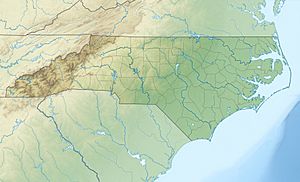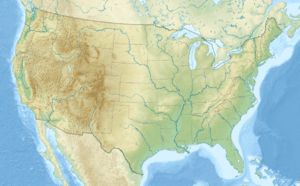Tomahawk Branch (Swannanoa River tributary) facts for kids
Quick facts for kids Tomahawk Branch |
|
|---|---|
|
Location of Tomahawk Branch mouth
|
|
| Other name(s) | Tributary to Swannanoa River |
| Country | United States |
| State | North Carolina |
| County | Buncombe |
| City | Black Mountain |
| Physical characteristics | |
| Main source | divide between Tomahawk Branch and North Fork Swannanoa River about 1.5 miles north of Black Mountain, North Carolina 2,570 ft (780 m) 35°38′28″N 082°20′05″W / 35.64111°N 82.33472°W |
| River mouth | Swannanoa River Black Mountain, North Carolina 2,280 ft (690 m) 35°36′32″N 082°20′08″W / 35.60889°N 82.33556°W |
| Length | 2.61 mi (4.20 km) |
| Basin features | |
| Progression | south |
| River system | French Broad River |
| Basin size | 1.96 square miles (5.1 km2) |
| Tributaries |
|
| Waterbodies | Lake Tomahawk |
| Bridges | Walker Cove Road, North Fork Road, W Chapel Road, Hiawassee Avenue, 9th Street, Park Lane, Cragmont Road, W State Street |
Tomahawk Branch is a small stream, about 2.61 mi (4.20 km) long, located in Buncombe County, North Carolina. It's like a smaller river that flows into a bigger one. This stream is a "first-order tributary," which means it's one of the smallest streams that flows directly into a larger river, the Swannanoa River.
One interesting feature of Tomahawk Branch is Lake Tomahawk. This lake was created by building a dam across the stream.
Where Does Tomahawk Branch Flow?
Tomahawk Branch starts its journey about 1.5 miles north of a town called Black Mountain, North Carolina. It begins in Buncombe County, high up where the land divides the water flowing into Tomahawk Branch from the water flowing into the North Fork Swannanoa River.
From its starting point, Tomahawk Branch flows south. It continues its path until it reaches and joins the Swannanoa River, right in the town of Black Mountain, North Carolina.
The Area Tomahawk Branch Drains
The area that collects rainwater and snowmelt for Tomahawk Branch is called its watershed. This watershed covers about 1.96 square miles (5.1 km2) of land.
Every year, this area gets a lot of rain, about 47.6 inches! A good portion of the land in the watershed, about 36%, is covered by forests. These forests help keep the water clean and healthy for the stream.



